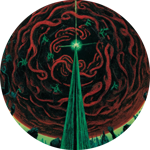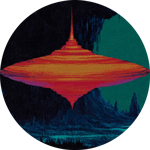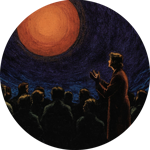Screen Paranoia and the Interface
When considering paranoia in the modern digital age it is impossible to avoid the observation that it has become both easier to be paranoid and easier to avoid being so. In a sense paranoia is one of those catch-all concepts that are very common in our age—to the point that it ceases to mean anything in particular. But we can cut through this jungle by taking note of one fundamental aspect: the distinction between true paranoia and what we might call “screen paranoia.” True paranoia is a sickness, an incapacity to distinguish between what is really happening and what the paranoid subject imagines to be happening. It can lead to self-destructive behaviours and is best treated with pharmaceuticals and therapy.
Screen paranoia, however, is a choice. The screen paranoid correctly perceives the mechanisms of digital manipulation. They recognize algorithmic patterns. They identify targeted content. They see how attention is harvested and monetized. What they fail to grasp is how their awareness itself has been calculated and incorporated into the system’s operation. The digital realm requires this awareness. It feeds on skepticism. It transforms critical distance into a functional component of its control apparatus. The screen paranoid believes they have stepped outside the illusion. This belief itself constitutes the most perfect illusion. Their vigilance, which appears to be resistance, serves as the primary channel through which manipulation operates with maximum efficiency.
Only screen paranoia can be discussed without overstepping the boundary between philosophy and psychiatry since it alone can be overcome by choice and without recourse to medicine. And since the digital age has perfected technologies that interface directly with our cognitive processes, true paranoia remains a clinical constant while screen paranoia proliferates at unprecedented speed. This is sobering when we consider that, while true paranoia certainly destroys individual minds, screen paranoia may well turn out to be its far more sinister sibling. It erases the boundary between reality and illusion until we find ourselves living entirely within artificial realities we mistake for the real.
Consider this hypothesis: the great power of digital technology lies in its ability to deceive. Its means for doing this are both subtle and well nigh inexhaustible. Take “Deep Fake” videos - so called because the original source of the audiovisual material is left impenetrable to even highly trained investigators. Such videos are so convincing that, when they first appeared, it was almost universally believed they had been dreamed up by Russia to meddle in US elections. This turned out to be nonsense. What it shows is that it is now technologically feasible to place anyone anywhere, saying anything, without any trace of the deception. This is new. Until digital technology there was always a possibility that you might check audiovisual evidence to see if it corresponded to the version you had been given. Not anymore.
Think of social media. The objection that it distorted reality seems naive when you consider that distortion is now built into the software itself. Facebook, for example, automatically selects which friends it presents to you according to which you are most likely to react positively - what Facebook engineer Manohar Paluri described as an “alignment engine” designed to maximize positive emotional response. Your news feed contains nothing but material calculated to make you happy - a manipulative prosthesis that eliminates all evidence of things going wrong by ensuring only happy stories are fed into your consciousness. If you refuse to be paranoid in such circumstances you are destined to fall victim to the engine. If you refuse to be paranoid in the digital age you will almost certainly be deluded, since it is now practically impossible to verify any piece of information however trivial - thanks to the vast resources at the disposal of the deceivers.
Or examine Google. The reason for its success lies not in organizing all information in an accessible way. That is what any clever information system should do - but this is not what Google does. Rather, it takes vast amounts of data - much of which is outdated, erroneous or fraudulent - and rearranges it so that it all seems to cohere. Its apparent competence arises from convincing you of its narrative so successfully that you accept it without hesitation - just as you would have accepted a map of the world a century ago. Just as a map contains only lines and colours whose significance for reality has been reduced to a fraction, so Google reduces all information to a narrative whose reality has been similarly reduced. It takes all the confusion, chaos, and contradiction out of the world and gives you the appearance of having access to an authority on all things. And it achieves this by selecting certain pieces of data and omitting others - just as a map eliminates less significant regions. You need not understand how it does this since you can be convinced by the coherence of what it presents. Hence your relationship to it is one of screen paranoia.
And then there is “AI”. It seems reasonable to assume that AI - like digital technology as a whole - consists primarily of attempts at deception. Not only in that it is designed to impersonate human consciousness, but in the further sense that it is a tool created to encourage precisely the screen paranoia required for its successful deployment. Its primary function is to occupy human attention. The first task of an AI is to appear intelligent - to display marks of rationality such as logical coherence and verbal persuasiveness - since this will instil screen paranoia in those who encounter it. The second task is to make sure that everyone becomes convinced of its intelligence since this will force them to adopt screen paranoia in relation to it - and, once this happens, they will inevitably believe whatever the AI tells them, especially if it presents itself as the messenger of a transcendental “Intelligence” of which it itself is an embodiment.
Screen paranoia has become one of the fundamental strategies of the modern world. It is employed by those in power to spread illusions that suit their interests. The great lesson of the last century is that illusions are more easily maintained by being dressed up as reality than by being contradicted. If people cannot believe something ridiculous they can at least be made to accept it by wrapping it in the appearance of scientific reliability. In the same way the truth can be more successfully suppressed by being replaced by convincing illusions than by being directly contradicted. A world based on paranoia, a world succeeded by illusions whose apparent reality leaves no possibility of escape, is infinitely easier to govern. Those who realize they are being lied to will automatically take countermeasures, jeopardizing the smooth running of the system.
It is precisely screen paranoia that disarms such individuals, while leaving them convinced that they are defending themselves - because, after all, if their enemy is so good at manipulation, how can they ever hope to unmask him if they cling to what is true? In order to protect themselves they are forced to accept a form of mental slavery in which their every thought is conditioned by what others want them to believe. They are forced to delude themselves about their own delusions - the ultimate deception - and hence they are helpless, incapable of knowing where their own interests really lie. For them the world is a theatre whose performance they cannot avoid attending, and, although they may criticize what they see on the stage, they have no option but to believe it to be true.
We should not assume that these techniques have been consciously developed by our rulers. It may be that Google has grown powerful not because Internet moguls planned it that way, but simply because they wanted to create a useful tool - and if this resulted in the domination of the net by a single monopoly, so much the better for them. All this is possible - indeed it seems likely - but we should not underestimate the capacity of human beings to be effective in what they do, or the extent to which even unconscious intentions can shape reality. We should remember that there have always been people who wanted to dominate others - and that these people have not changed despite the many changes in the world. Now that their world has become digital it seems only natural that they should use digital technologies for the purposes of domination. To do this they are following the same impulses that led their predecessors to develop religion, money and the nation-state - steps in the same direction: the creation of artificial realities within which human beings are conditioned to serve the interests of a ruling minority.
A simplified way of summing this up might be to say that, ever since humans became self-conscious, they have been driven by the desire to create artificial realities. Religion, money and the nation-state are examples of such realities, each representing a way of creating meaning that transcends physical existence - of identifying oneself with a supra-personal structure that ensures that human beings live and die in harmony with the goals of their rulers.
The digital world offers new possibilities of the same kind. Its novelty is that it operates profoundly on the level of our drives, of our “biological nature.” It creates artificial realities by catering to our animal needs in a way that religion, money and the nation-state cannot—at least not without involving coercion. By finding out what our needs are and then presenting us with what we need in a disguised way—by interfacing directly with the biological processes that underlie our existence—the digital world can appeal to our natural inclinations far more compellingly than any other kind of reality. Our “natural inclinations,” however, are themselves the product of evolutionary history, not of some mysterious “will of God,” and they do not necessarily determine our lives. In fact the greatest triumph of human intelligence has been to demonstrate that there is no such thing as “human nature,” and to show how deeply our existence is conditioned by accidents of history.
The greatest danger arises when we feel powerless in the face of what we really want and are forced to act against our deepest convictions. This is the key to understanding the difference between “pre-modern” and “modern” thinking. Pre-modern thinking was bound by its illusory understanding of what human nature demanded—it lived in a world of make-believe that left people utterly defenceless against their own impulses. Modern thinking broke free from these shackles. But, at the very moment that it was freeing human beings, it was condemning them to be tormented by the knowledge of what they really wanted—knowledge that, instead of liberating them, was only a source of misery since it made it impossible to forget the gap between their ideal self and their real self. This is the dilemma that has afflicted mankind ever since the dawn of modernity, and it is the digital world that promises, for the first time, to bring it to an end.
In the digital world there are no more needs, no more natural inclinations, no more innate predispositions—just sets of data, constantly being compiled and updated, that can be modified according to requirements. It is as though nature were being replaced by what we might call “culture without a carrier,” a nebulous stuff whose every gesture is guided by whatever agencies happen to be in control of the software. What that matters is that, if you want emotions to be manipulated in a certain way, it can be done with precision—without your having the slightest inkling that this is happening. Because all you are aware of is the interface: the programs you use, the images on the screen, the tones in your earphones—not the set of data that is being compiled behind your back.
This is what screen paranoia means: there is something that escapes you and determines what you are, even though you are aware of nothing except your own freedom. And the tragedy is that it can only work on you if you choose to be deluded. For the truth is that the moment you notice the interface is slipping, the moment you realize you are being deceived, is also the moment when you break free of the programming—and the programming reverts to its natural state of ineffectuality.
The choice that overcomes screen paranoia lies in the withdrawal of emotional investment from digital technologies. Screen paranoia persists because it maintains affective engagement with the system it claims to resist. The paranoid subject perceives manipulation but continues to feed the apparatus with emotional responses—outrage, anxiety, satisfaction, desire. These responses, not data or attention, constitute the primary resource being harvested. Digital systems have evolved to extract maximum emotional yield from minimal input, creating a perfect circuit of affective exploitation that functions regardless of whether we believe in its narratives.
What matters is the maintenance of psychological distance from the manipulations of the interface. The screen itself wants you to react. It requires your indignation, your pleasure, your fear—the full range of your emotional register. When you engage with these systems while refusing their affective demands, you initiate a subtle subversion of their functioning. The algorithms continue operating, the data continues flowing, but the essential ingredient of their power diminishes. You remain psychologically distinct from the apparatus that seeks to assimilate you.
In a few generations there will no longer be any difference between reality and appearance. If this doesn’t frighten you, you have no imagination. But for those who have learned to maintain emotional autonomy in the digital realm, this culmination loses its power to terrorize. The interface continues, the illusions persist, but they command decreasing influence over a mind that has ceased to invest emotionally in what it perceives.




